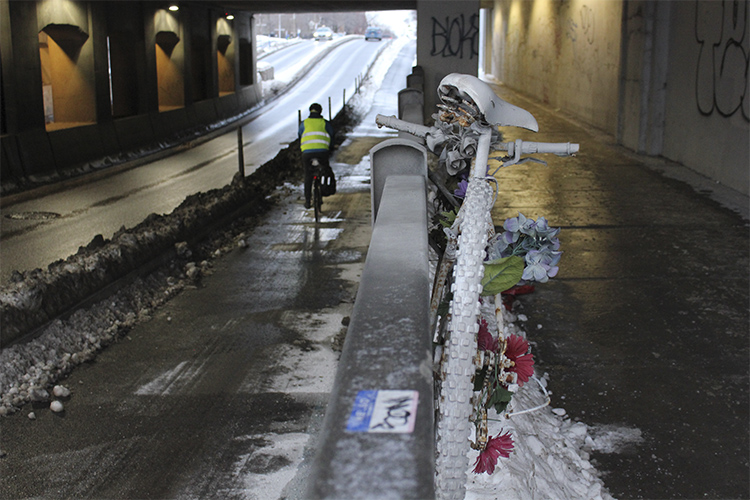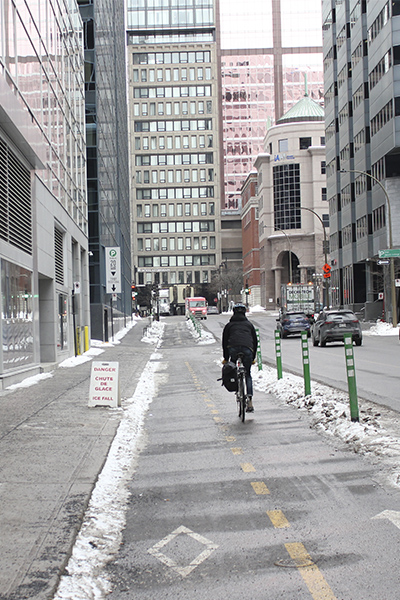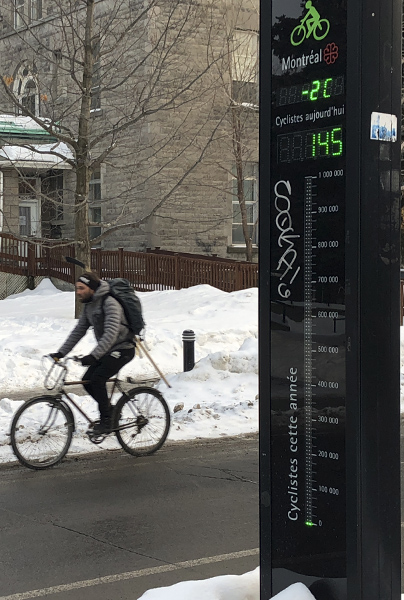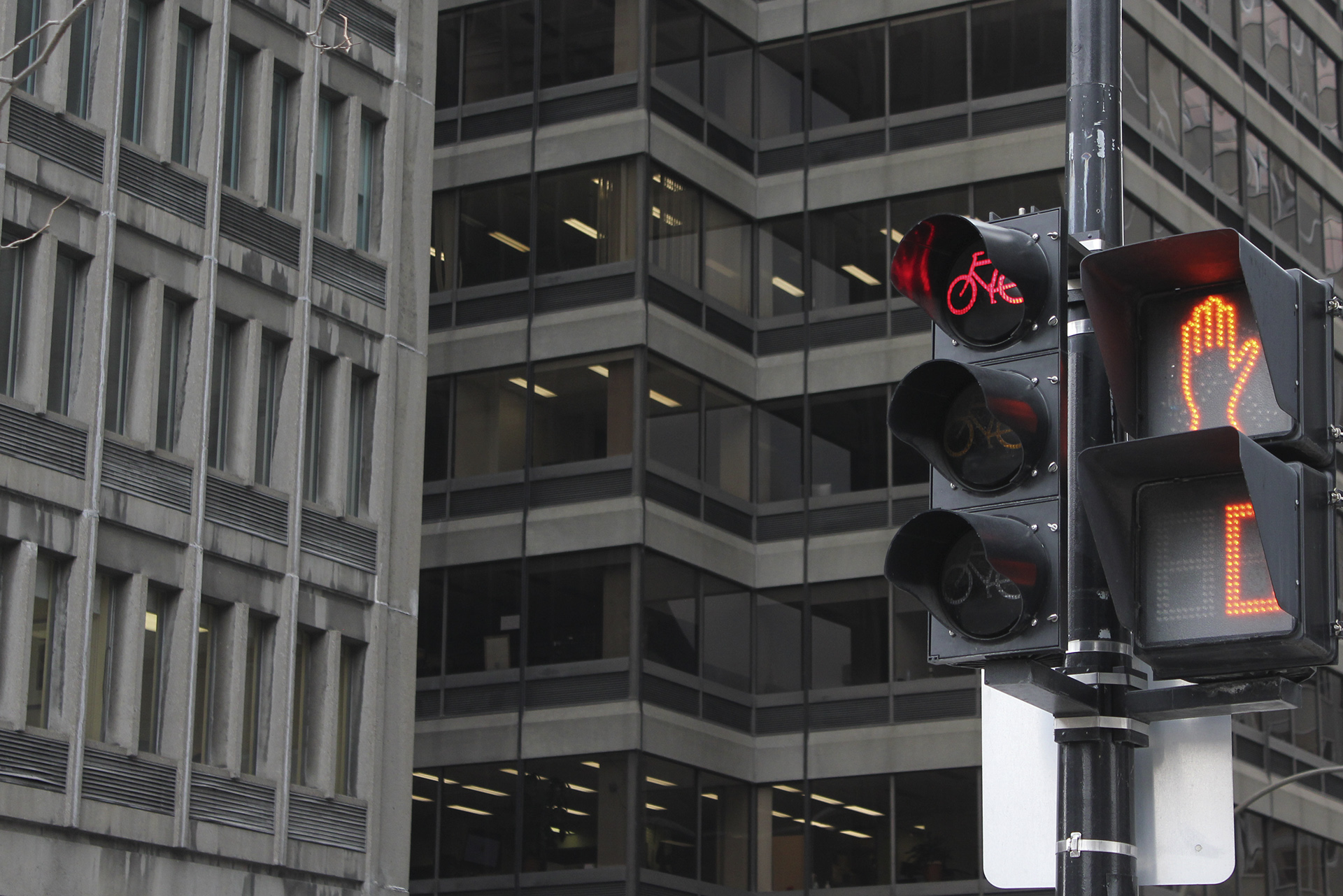BY Adrien Congourdeau & Marcus Bankuti
Marc Guindon has been working as a bike courier in Montreal for four years now, most recently with rider-run delivery service Chasseurs Courrier. Guindon says he hasn’t had any serious accidents while on the job, but several of his friends have not been so lucky.
“A friend of mine who is not an avid cyclist, I think in her first two weeks [of cycling] got a door opened on her, in one of these ‘fake’ cycling lanes that are basically just painted lines,” says Guindon. “Usually the lines are painted in what we call the ‘door zone’ which is where people will open their doors.”
Guindon notes that many of the city’s pre-existing bike lanes are nothing more than painted lines, meaning cyclists often have to cross on to the road to avoid parked cars, which can be both daunting and dangerous.
“It’s way better to have a car honking at you than to have a door in your face,” remarks Guindon.
St. Denis St. has been one of the more dangerous roads for cyclists due to there being four lanes of traffic, and no bike lane. In 2014, 33-year-old cyclist Mathilde Blais was struck and killed on her way to work by a large truck beneath the underpass south of Rosemont Blvd.
A white bicycle honours the memory of Mathilde Blais, a cyclist killed on St-Denis St. in 2014, prior to the installation of a bike path. Photo by Marcus Bankuti.
Incidents such as these are why many cyclists are looking forward to Projet Montréal’s Réseau Express Vélo (REV). The project aims to add 184km of bike lanes to Montreal’s cycling infrastructure. The city hopes that it will help cycling represent 15 per cent of all transport within ten years.
However, the project is not without controversy among merchants and residents. A bike lane on Terrebonne street in NDG was removed shortly after its installation following a backlash from residents. The St. Denis Street bike lane was also hotly contested by merchants who claimed they were not properly consulted.
A major bike path installed last year on St-Denis St. has caused anxiety for business owners, even as some see it as part of a brighter future for the beleaguered street. Video by Marcus Bankuti.
Although the public’s complaints have led to the removal of the Terrebonne route, many complaints are not about the bike lanes themselves. Rather, people have complained to the city about a lack of communication and consultation. According to some political observers, this could become a decisive factor for voters at election time.
Meghan Joy, an Assistant Professor of Political Science at Concordia University says that while she does not believe the issue in and of itself will necessarily sway voters’ decisions, it does have potential to influence the vote.
“Issue-based voting is definitely common in municipal elections,” says Joy. “Voters might very well vote against a party because of particular projects, especially if there is a viable alternative incumbent/party. In some cases, a particular project may act as the final straw in a progression of dissatisfactions with a party/politician.”
Christian Arseneault, an independent councillor was with Projet Montréal during the implementation and removal of the Terrebonne bike lane. Now an independent councillor, he says that the city needs to learn from its mistakes with Terrebonne and assure that citizens are made aware of the timetables for large projects.
“It doesn’t matter whether or not you have a consultation, but when you don’t even alert people, and when they wake up one morning and realize that the [street] signs have been changed and they’ve been ticketed overnight, there’s no excuse for that,” he says. “That demonstrates not only a lack of interest in people’s opinions, but a total disregard for them as citizens.”
Arseneault believes that many people on Terrebonne would have otherwise been on board with the project had it not been for the lack of communication.
“We really shot ourselves in the foot in that regard, because on one hand, it frustrated people who were otherwise okay with it. We got plenty of emails from people saying, ‘I’m all in favour of bike paths but you can’t behave this way as a public institution,’” he says. “On the other hand, it also energized those who didn’t want them at all, who were categorically against bike paths because it fits into their narrative that we are doing this for dogmatic and ideological reasons and [that] we don’t care what anyone says, and [that] that’s why we didn’t reach out.”
This map shows the planned Terrebonne bike lane in the NDG borough, as well as the existing dedicated lanes. Media by Adrien Congourdeau.
After receiving over 300 complaints the Montreal Ombudsman reported that the REV and Voies Actives Securitaires (VAS), did not meet certain requirements stated in the Montreal Charter of Rights and Responsibilities.
The opposition, Ensemble Montréal, have also been vocal on the matter.
“It is clear that Projet Montréal only thought of their electoral base rather than take into consideration people with reduced mobility, the elderly, or the merchants on the affected arteries,” says Thomas W. Marchand, a spokesperson for Ensemble Montréal. “The 300 complaints to the ombudsman are proof of this.”

A cyclist travels west on Avenue du Président-Kennedy, which connects to the popular De Maisonneuve bike path downtown. Photo by Marcus Bankuti
However, Émilie Thuillier, the Mayor of Ahuntsic-Cartierville and member of Projet Montréal, claims to have received overwhelmingly positive feedback for the REV developments on Lajeunesse and Berri streets in her borough.
“We elected officials receive a lot of questions and complaints over email, very rarely do we receive positive feedback. That is not the case with bike lanes,” says Thuillier. “I receive plenty of testimonies by email but also from people who see me in the street and stop me to say things like ‘You’ve changed my life.’ It’s crazy, people say ‘Thanks to you I can take my child to school by bike which I couldn’t do before.’”

A counter in front of Laurier Station tracks how many cyclists use the bike lane each day and throughout the year. Photo by Marcus Bankuti.
Mayor Thuillier also notes that while projects like the REV are city-wide, the public’s needs vary from borough to borough, and therefore consultation and planning must be catered and communicated differently by each borough’s elected officials.
“When discussing bike lanes it is not only the people from the street that you need to consult, but the neighborhood as a whole,” says Thuillier. “I can’t speak for other administrations or boroughs because each has their own game plan, but in our borough, we did extensive consultation and communicated our intentions through all mediums possible.”
There is no way to predict for sure how this situation will affect Projet Montréal in the upcoming election, but it has certainly left a bitter taste for some voters.
“Some voters who already have issues with the party are likely losing even more faith with councillors leaving the party,” says Joy. “Others convinced that Plante is doing what she needs to follow through on the party’s promises and goals may see this as illustrative of leadership. We will see how this plays out soon.”




